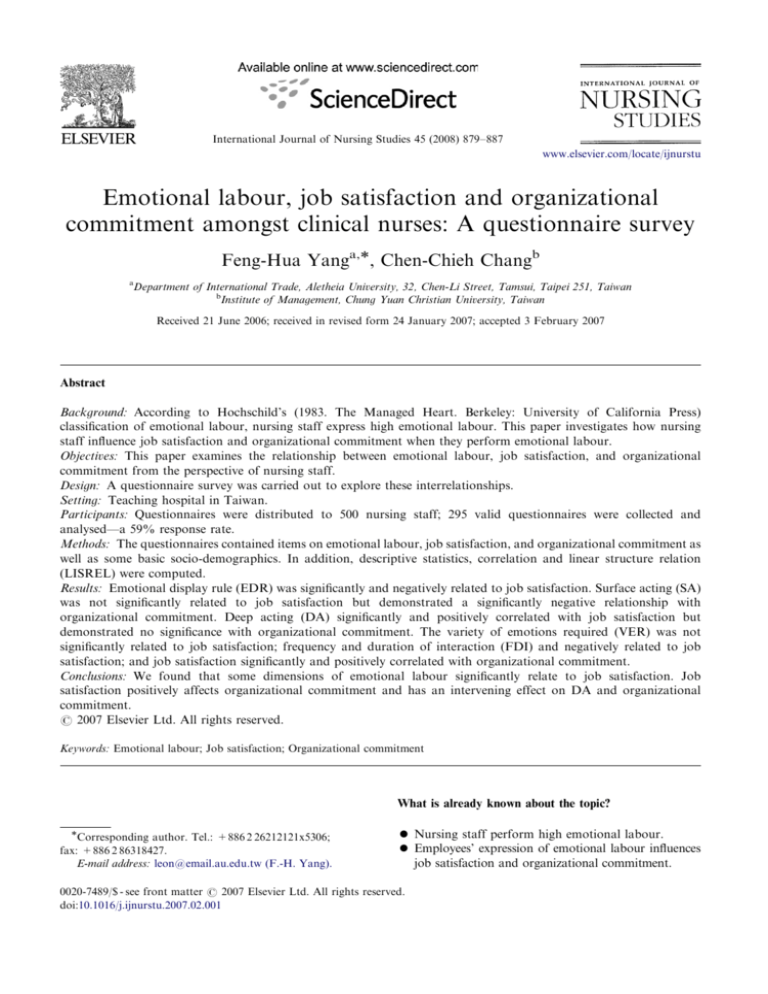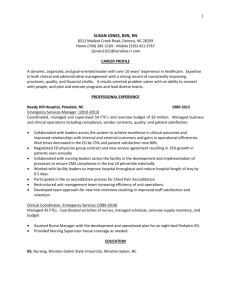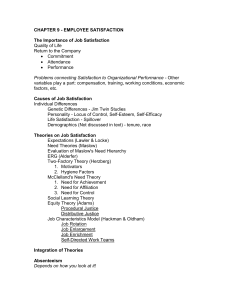
ARTICLE IN PRESS
International Journal of Nursing Studies 45 (2008) 879–887
www.elsevier.com/locate/ijnurstu
Emotional labour, job satisfaction and organizational
commitment amongst clinical nurses: A questionnaire survey
Feng-Hua Yanga,, Chen-Chieh Changb
a
Department of International Trade, Aletheia University, 32, Chen-Li Street, Tamsui, Taipei 251, Taiwan
b
Institute of Management, Chung Yuan Christian University, Taiwan
Received 21 June 2006; received in revised form 24 January 2007; accepted 3 February 2007
Abstract
Background: According to Hochschild’s (1983. The Managed Heart. Berkeley: University of California Press)
classification of emotional labour, nursing staff express high emotional labour. This paper investigates how nursing
staff influence job satisfaction and organizational commitment when they perform emotional labour.
Objectives: This paper examines the relationship between emotional labour, job satisfaction, and organizational
commitment from the perspective of nursing staff.
Design: A questionnaire survey was carried out to explore these interrelationships.
Setting: Teaching hospital in Taiwan.
Participants: Questionnaires were distributed to 500 nursing staff; 295 valid questionnaires were collected and
analysed—a 59% response rate.
Methods: The questionnaires contained items on emotional labour, job satisfaction, and organizational commitment as
well as some basic socio-demographics. In addition, descriptive statistics, correlation and linear structure relation
(LISREL) were computed.
Results: Emotional display rule (EDR) was significantly and negatively related to job satisfaction. Surface acting (SA)
was not significantly related to job satisfaction but demonstrated a significantly negative relationship with
organizational commitment. Deep acting (DA) significantly and positively correlated with job satisfaction but
demonstrated no significance with organizational commitment. The variety of emotions required (VER) was not
significantly related to job satisfaction; frequency and duration of interaction (FDI) and negatively related to job
satisfaction; and job satisfaction significantly and positively correlated with organizational commitment.
Conclusions: We found that some dimensions of emotional labour significantly relate to job satisfaction. Job
satisfaction positively affects organizational commitment and has an intervening effect on DA and organizational
commitment.
r 2007 Elsevier Ltd. All rights reserved.
Keywords: Emotional labour; Job satisfaction; Organizational commitment
What is already known about the topic?
Corresponding author. Tel.: +886 2 26212121x5306;
fax: +886 2 86318427.
E-mail address: leon@email.au.edu.tw (F.-H. Yang).
Nursing staff perform high emotional labour.
Employees’ expression of emotional labour influences
0020-7489/$ - see front matter r 2007 Elsevier Ltd. All rights reserved.
doi:10.1016/j.ijnurstu.2007.02.001
job satisfaction and organizational commitment.
ARTICLE IN PRESS
F.-H. Yang, C.-C. Chang / International Journal of Nursing Studies 45 (2008) 879–887
880
Correlation
coefficients denoting the relationship
between emotional labour and job satisfaction range
from 0.16 to 0.44.
What this paper adds
Some
dimensions of emotional labour significantly
relates to job satisfaction.
Job satisfaction has an intervening effect on deep
acting and organizational commitment.
The theoretical model proposed by this paper is
deemed a good fit.
1. Introduction
The first definition of emotional labour was proposed
by Hochschild (1983). Emotional labour requires that
one expresses or suppresses feelings that produce an
appropriate state of mind in others; that is, a sense of
being cared for in a convivial and safe place. When
emotions are transferred from personal behaviours to
commodities, organizations have begun to consider
using managerial measures to make employees utilize
emotional labour to maximize efficiency while working
(Morris and Feldman, 1996).
Emotional labour is considered by many to be an
important part of the role of many health care
professionals and it has been the focus of much debate
and empirical enquiry within a range of health care
settings, especially in nursing (Mann, 2005). According
to Hochschild’s (1983) classification of emotional
labour, nursing staff are required to express a higher
degree of emotional labour compared with other
professional and technical staff with similar jobs.
Numerous scholars have investigated the role of
emotional labour in nursing. According to Mann and
Cowburn (2005), nurses who perform emotional labour
are able to manage patient reactions by providing
reassurance and an outlet for emotions, thus directly
impacting their psychological and physical well-being
and recovery. Lynch (1989) argued that emotional
labour performed by nurses, to a certain extent,
generates and maintains ‘‘solidarity relationship.’’ That
is, emotional labour establishes an interpersonal relationship and is a symbolic expression of emotional
concern and caring that enables patients to feel at ease
and trust the nurses’ motives and actions (O’Brien,
1994). Smith and Kleinman (1989), in a study of medical
professionals, noted that their development toward
emotional neutrality is part of a hidden curriculum.
Under great pressure to prove that they are worthy of
entering the nursing profession, students are afraid to
admit that they are uncomfortable with patients or
procedures, typically hiding these feelings behind a
‘‘cloak of competence.’’
Cranny et al. (1992) defined job satisfaction as ‘‘an
affective (that is, emotional) reaction to one’s job,
resulting from an incumbent’s comparison of actual
outcomes with desired (expected, deserved, etc.)
outcomes’’. Locke (1969) argued that job satisfaction
is the ‘‘pleasurable emotional state resulting from
appraisal of one’s job as achieving or facilitating one’s
job values’’. Job dissatisfaction, meanwhile, is an
unpleasurable emotional state resulting from an appraisal of one’s job as frustrating or blocking the attainment
of one’s values. It is therefore clear from the above that
job satisfaction is an integral variable of organizational
theory.
Previous theoretical work on emotional labour
suggested a negative relationship between emotional
labour and job satisfaction. However, two empirical
tests of this relationship (Adelmann, 1989, Wharton,
1993) contradicted the above view. Moorman’s (1993)
study found that when only one dimension is used to
measure the relationship between emotional labour and
job satisfaction, the correlation coefficients range from
0.16 to 0.44, suggesting that measuring emotional
labour with only one dimension is inappropriate. Not
until Morris and Feldman (1996) used an emotional
interaction module to redefine emotional labour. Lin
(2000) studied emotional labour and found that it
should be measured using five dimensions—emotional
display rule (EDR), surface acting (SA), deep acting
(DA), variety of emotions required (VER), frequency
and duration of interactions (FDI). However, few
studies have investigated the relationship between these
dimensions and job satisfaction.
Ekman (1973) referred to the rules regarding appropriate emotional expression display rules. According to
Ekman, display rules are norms and standards of
behaviour indicating what emotions are appropriate in
a given situation and how these emotions should be
publicly expressed. In the topic of display rules,
Ashforth and Humphrey (1993) emphasized on the
expression aspect whereas Hochschild (1983) noted that
managing inner feelings is crucial. Hochschild (1983),
who pointed out that emotions cause alienation and
estrangements from one’s feelings, further hypothesized
that emotional display is negatively correlated with job
satisfaction.
In SA, employees modify and control their emotional
expressions (Morris and Feldman, 1997; Pugliesi, 1999;
Lin, 2000). For example, employees may fake a smile
when in a bad mood or interacting with a difficult
customer. Morris and Feldman (1997) identified conflicts between emotions genuinely felt and emotions to
be displayed in organizations as ‘‘emotional dissonance’’. In other words, the act of expressing sanctioned
emotions during interpersonal interactions becomes
more demanding when expression requires increased
effort to control true feelings. Rutter and Fielding (1988)
ARTICLE IN PRESS
F.-H. Yang, C.-C. Chang / International Journal of Nursing Studies 45 (2008) 879–887
found that a need to suppress inauthenticity felt
emotions was negatively correlated with job satisfaction.
Hochschild (1983) defined ‘‘deep acting’’ as individuals trying to influence what they feel in to ‘‘become’’
the role they are asked to play. In this case, expressive
behaviours and inner feelings are regulated (Zapf, 2002;
Lin, 2000). DA is when an employee must expend effort
to regulate emotions. During DA, there is a need to
actively strive to invoke thoughts, images, and memories
to induce a certain emotion (Ashforth and Humphrey,
1993). Broheridge and Grandey (2002) argued that DA
involves treating a customer as someone deserving
authentic expression, and the positive feedback from a
customer can increase personal efficacy. We propose
that DA is positively correlated with job satisfaction.
Morris and Feldman (1996) opined that emotional
work requires expression of a variety of emotions. The
requirement to display emotions can be either positive,
neutral—in the case of a judge who wants to display
dispassionate authority and independence—or negative,
e.g., a policeman who shows severity and anger when
communicating with drunken adolescents. There are
some jobs, such as kindergarten teachers, nurses, and
psychotherapists in which a variety of emotions are
required (Zapf, 2002; O’Brien, 1994). Frequent changes
in the emotions displayed over a limited period require
more planning and anticipation on the part of employees, and thus, they entail greater emotional labour and
more role load (Morris and Feldman, 1996; Lin, 2000).
Therefore, the need to express a variety of emotions
should be negatively correlated with job satisfaction.
Frequency of emotional displays has been the most
examined component of emotional labour (Morris and
Feldman, 1996; Zapf, 2002). In fact, more or less, all
studies that somehow measured emotion work measured
the frequency and it was the basic idea of Hochschild
(1983) that too frequent emotional displays would
overtax the employees and lead to alienation and
exhaustion (Zapf, 2002). Rafaeli (1989) and Sutton
and Rafaeli (1988) investigated convenience stores and
suggested that the duration of interaction is related to
the scriptedness of social interactions. This finding
implies that the level of effort required for emotional
display in a short period is minimal. Conversely,
emotional displays of long duration should require
more effort, and thus, increased emotional labour
(Morris and Feldman, 1996; Lin, 2000). Thus, FDI
should be negatively correlated with job satisfaction.
Udo et al. (1997) argued that how satisfied employees
feel about their jobs affects their loyalty towards their
organizations. Mowday et al. (1982) pointed out that job
satisfaction can be an antecedent variable for organizational commitment. A number of studies found that job
satisfaction positively correlates with organizational
commitment (Martin and Bennett, 1996; Schwepker,
2001).
881
Although there are several definitions of organizational commitment, a common theme in most is that
committed individuals believe in and accept organizational goals and values, and are willing to remain within
their organizations, and willing to provide considerable
effort on their behalf (Mowday et al., 1979). Hence,
organizational commitment acts as a ‘‘psychological
bond’’ to an organization that influences individuals act
in ways that are consistent with the organization’s
interests (Porter et al., 1974). High or low organizational
commitment is related to employee’s turnover intention
(Martin and Bennett, 1996; Schwepker, 2001; Wong and
Law, 2002) and productivity (Becker et al., 1996; Martin
and Bennett, 1996). Wong and Law (2002) stated that
employees’ performance of emotional labour changes
their organizational commitment. Grandey (2000) noted
that in studying emotional labour, a trend is to measure
SA and DA. Thus, this study explores how SA and DA
affect organizational commitment.
Hochschild (1983) argued that inauthentic SA over
time results in a feeling detachment from one’s true
feelings and from others’ feelings. Feeling-diminished
personal accomplishment is likely when an employee
believes that the displays were not efficacious or were
met with annoyance by customers (Ashforth and
Humphrey, 1993). The inauthenticity of this surface
acting process, showing discrepant from feelings, affects
employee behaviour (Pugliesi, 1999; Ashforth and
Humphrey, 1993). We propose that SA is negatively
correlated with organizational commitment.
Hochschild (1983) discussed two avenues for DA: (a)
exhorting feelings, whereby one actively attempts to
evoke an emotion; and, (b) trained imagination, whereby one actively invokes thoughts, images, and memories
to induce the associated emotion (thinking of a wedding
to feel happy). DA is directly focused on one’s inner
feelings (Ashforth and Humphrey, 1993; Mann, 2004);
given the increased psychic effort involved in DA,
this form of emotional labour is more consistent
with a strong concern for one’s customers. We propose
that DA is positively correlated with organizational
commitment.
Based on literature findings and empirical study, this
paper investigates the relationship between emotional
labour performed by nursing staff and job satisfaction
and organizational commitment.
2. Method
2.1. Participants and procedure
In total, 500 full-time nurses participated in this study.
Participants in this convenience sample returned 295
valid questionnaires—a 59% response rate. The sample
was 100% female, of which 28.5% were married. Most
(89.5%) were aged o35 years. Most had 43 years of
ARTICLE IN PRESS
882
F.-H. Yang, C.-C. Chang / International Journal of Nursing Studies 45 (2008) 879–887
work experience (60%) and 28.5% had X7 years of
experience.
Wallbott and Scherer (1989) indicated that the use of
a questionnaire to collect information about emotional
experience and expression can offer a number of
advantages, including assess to more emotional experiences over a longer period of time. All respondents
participated voluntarily in the study, and assurances of
anonymity were made and kept. Non-response bias was
checked by means of a time trend extrapolation test in
which characteristics of early respondents were compared with those of late respondents (Armstrong and
Overton, 1977). No significant differences were identified (F ¼ 0.65, po0.687), suggesting that non-response
bias is less likely.
2.2. Measures
This study utilized a pretest to enhance reliability and
validity. When the corrected item-total correlation was
o0.45, and deleting the item increased Cronbach’s a, the
item was deleted.
Emotional labour was measured with a slightly
modified scale developed by Lin (2000). The 24-item
measure contained five dimensions—EDR, SA, DA,
VER, and FDI. A 7-point Likert scale was used, with
anchors ranging from 1 (strongly disagree) to 7 (strongly
agree). EDR was the level to which employees reported
that their emotional displays were controlled by their
jobs. Items asked the extent to which the employee is
required by organization to show (or hide) emotion in
order to be effective on the job. SA refers to modifying
and faking expressions. DA is the extent to which an
employee modifies feelings to meet display rules. VER is
the need to display different emotions with different
patients. FDI is the average number of minutes and rate
required for a typical transaction. Four items were
deleted after the pretest. Internal consistency was
measured using Cronbach’s a with reliability coefficients
of 0.79 for EDR (five items), 0.85 for SA (three items),
0.85 for DA (six items), 0.86 for VER (four items) and
0.75 for FDI (two items).
Job satisfaction was adopted from the Minnesota
Satisfaction Questionnaire (Weiss et al., 1967). It was
measured using a 20-item scale containing two dimensions: internal satisfaction (IS) and external satisfaction
(ES). A 7-point Likert scale was adopted, with anchors
ranging from 1 (strongly disagree) to 7 (strongly agree).
No item was deleted during the pretest. Internal
consistency was measured using Cronbach’s awith
reliability coefficients of 0.92 for IS (twelve items) and
0.83 for ES (eight items).
Organization commitment was measured by the
Organization Commitment Questionnaire developed by
Mowday et al. (1982), which used 15 items containing
three dimensions: value commitment (VC), effort
commitment (EC) and, retention commitment (RC). A
7-point Likert scale was used, with anchors ranging
from 1 (strongly disagree) to 7 (strongly agree). This
questionnaire has six reverse items. One item was deleted
after the pretest. Internal consistency was measured
using Cronbach’s a; reliability coefficients were 0.81 for
VC (five items), 0.81 for EC (four items) and 0.87 for RC
(five items).
Socio-demographic variables, such as age, gender,
employment status, and marital status were examined.
Table 1 provides the reliability analysis results of
emotional labour, job satisfaction and organizational
commitment. Each scale had satisfactory reliability with
coefficient a above 0.70.
Furthermore, this study examined convergent
and discriminant validity using confirmatory factor
analysis on LISREL VII (Jöreskog and Sörbom,
1982). Evidence of convergent validity was found in
the parameter estimates and t-values. First, parameter estimates were high in value and t-values were
statistically significant (greater than 2.0), meeting
the criteria proposed by Anderson and Gerbing (1988)
for convergent validity. Second, the proportion of
variation in the indicators captured by the underlying constructs should be higher than the variance
due to measurement error (Fornell and Larcker,
1981). The values of the average variance extracted
were 0.56 for EDR, 0.65 for SA, 0.61 for DA, 0.78 for
VER, 0.74 for FDI, 0.50 for IS, 0.48 for ES, 0.67 for VC,
and 0.56 for EC, 0.62 for RC. Almost all exceeded a
suggested critical value of 0.50 (Fornell and Larcker,
1981).
Table 1
Reliabilities analysis
Dimensions
Cronbach a Dimensions
Cronbach a Dimensions
Emotional display rule
Surface acting
Deep acting
Variety of emotional required
Frequency and duration of interaction
.79
.85
.85
.86
.75
Internal satisfaction .92
External satisfaction .82
Value commitment
Effort commitment
Retention commitment
Emotional labour
.89
Job satisfaction
Organizational commitment .91
.93
Cronbach a
.81
.81
.87
ARTICLE IN PRESS
F.-H. Yang, C.-C. Chang / International Journal of Nursing Studies 45 (2008) 879–887
883
goodness-of-fit index (GFI) of 0.90, comparative fit
index (CFI) of 0.93, and root mean square residual
(RMSE) of 0.049, indicating acceptable fit.
Table 3 presents the LISREL estimates of structural
model coefficients. The path coefficients from emotional
display rule to job satisfaction were significant and
negative (g11 ¼ 0.24, t ¼ 2.93). SA was not significantly correlated with job satisfaction (g21 ¼ 0.10,
t ¼ 1.25), but significantly and negatively correlated
with
organizational
commitment
(g12 ¼ 0.23,
t ¼ 3.35). DA was significantly and positively correlated with job satisfaction (g31 ¼ 0.30, t ¼ 3.24), but not
with organizational commitment (g22 ¼ 0.10, t ¼ 1.30).
Thus, when SA, nurses modify and control their
emotional expressions. The inauthenticity of this surface-level process, showing expressions that differ from
their feelings, is not significantly related to job satisfaction but significantly related to organizational commitment. DA is the process in which internal thoughts and
feelings are altered to meet mandated display rules. DA
is significantly related to job satisfaction but not with
organizational commitment. VER was not significantly
correlated with job satisfaction (g41 ¼ 0.15, t ¼ 1.88).
FDI was significantly and negatively correlated with job
satisfaction (g51 ¼ 0.16, t ¼ 2.11). Job satisfaction
was significantly and positively correlated with organizational commitment (b11 ¼ 0.76, t ¼ 5.26).
Going a step further, we explored whether job
satisfaction has an intervening effect between SA, DA,
and organizational commitment. Table 4 presents the
results. Job satisfaction did not have a significant
intervening effect on SA (b ¼ 0.08, t ¼ 1.25). Thus, SA
cannot affect organizational commitment through job
satisfaction. However, job satisfaction demonstrated a
significant intervening effect on DA (b ¼ 0.23, t ¼ 3.20).
Thus, DA affects organizational commitment through
job satisfaction.
Discriminant validity can be established by demonstrating that the average variance extracted by a
particular construct from its indicators is greater
than its squared correlation (shared variance) with
another construct (Fornell and Larcker, 1981). Each
of the squared phi coefficients between EDR and
every other variable in the study was examined.
Results indicated that each construct’s average variance extracted was greater than its shared variance
with EDR. The following are the shared variances
between EDR and SA (0.30), DA (0.01), VER (0.00),
FDI (0.35), IS (0.18), ES (0.14), VC (0.13), EC (0.18),
and RC (0.14). Results of these analyzes provided
evidence for convergent and discriminant validity of the
constructs.
3. Results
Table 2 provides the means, standard deviations and
correlations for variables in this study. EDR was
significantly correlated with all job satisfaction subscales
and the organizational commitment subscale. Surface
acting did not exhibit significant correlation with the job
satisfaction subscale but show partial significance with
the organizational commitment subscale. DA was
significantly correlated with all job satisfaction subscales; however, DA was not significantly correlated
with organizational commitment subscales. VER was
not significantly correlated with job satisfaction subscales. FDI demonstrated a partially significant correlation with job satisfaction subscales.
To test the model presented in Fig. 1, structural
equation modelling was implemented by LISREL 8
(Jöreskog and Sörbom, 1982). As recommended by
Anderson and Gerbing (1988), covariance matrices were
used as input for LISREL analyses. The fit indices for
the structural model included a w2/df ratio of 3.12,
Table 2
Means, standard deviations, correlation matrix
Variables
Mean
SD
1
2
3
4
5
6
7
8
9
10
l. EDR
2. SA
3. DA
4. VER
5. FDI
6. IS
7. ES
8. VC
9. EC
10. RC
5.46
5.60
6.41
3.91
5.56
5.18
4.59
4.52
4.90
4.49
1.38
1.05
0.57
1.42
1.03
0.93
1.04
0.92
0.95
1.11
1.00
0.47**
0.33**
0.01
0.29**
0.32**
0.35**
0.36**
0.31**
0.33**
1.00
0.26**
0.30**
0.36**
0.05
0.12
0.40**
0.02
0.38**
1.00
0.52**
0.30**
0.63**
0.47**
0.06
0.07
0.07
1.00
0.34**
0.08
0.10
0.17**
0.34**
0.19**
1.00
0.29**
0.01
0.04
0.09
0.11
1.00
0.83**
0.66**
0.56**
0.57**
1.00
0.58**
0.54**
0.53**
1.00
0.65**
0.76**
1.00
0.56**
1.00
Note: EDR, Emotional display rule; SA, surface acting; DA, deep acting, VER, variety of emotional required; FDI, frequency and
duration of interaction; IS, internal satisfaction; ES, external satisfaction, VC, value commitment; EC, effort commitement; RC,
retention commitment.*po0.05 **po0.01.
ARTICLE IN PRESS
F.-H. Yang, C.-C. Chang / International Journal of Nursing Studies 45 (2008) 879–887
884
-0.23
SA (X2)
0.10
EDR(X1)
-0.24
0.15
VER(X4)
-0.16
FDI(X5)
0.30
DA(X3)
0.76
Job satisfaction
0.49
IS(Y1)
0.83
ES(Y2)
Organizational
commitment
0.81
0.80
VC(Y3)
EC(Y4)
0.54
RC(Y5)
0.10
Fig. 1. Structural model coefficients. Note: w2 (df ¼ 26) ¼ 96.83 (P ¼ 0.000), 2. GFI ¼ 0.90, CFI ¼ 0.93, 3. RMSR ¼ 0.049.
Table 3
Path coefficient
Independent variable
Dependent variable
Job satisfaction
Emotional display rules
Surface acting
Deep acting
Variety of emotional required
Frequency and duration interaction
Job satisfaction
0.24** (2.93)
0.10 (1.25)
0.3** (3.24)
0.15 (1.85)
0.16* (2.11)
Organizational commitment
0.23** (3.35)
0.1 (0.30)
0.76** (5.26)
Note: ( ) is t value, *po0.05, **po0.01.
Table 4
Intervening effect with job satisfaction
Independent variable
Dependent variable
Organizational commitment
Surface acting
Deep acting
0.08 (1.25)
0.23** (3.20)
Note: ( ) is t value, *po0.05, **po0.01.
4. Discussion
Many scholars studying the relationship between
emotional labour and job satisfaction found different
results given in different subjects and industries. For
example, in an exploratory research on flight attendants,
Hochschild (1983) contended that having to perform
emotional labour causes eventual alienation or estrangement from one’s genuine feelings, and it thereby has
detrimental consequences for various aspects of psychological well-being.
Morris and Feldman (1997) provided direct empirical
evidence that previous research has overemphasized the
negative aspects of emotional labour. Sampling employees from multiple job categories in debt collection
agencies, military recruiting battalion headquartered
and nursing, Morris and Feldman found that emotional
dissonance is associated with higher emotional exhaustion and lower job satisfaction.
Wharton’s (1993) examination of the emotional labour
offered results that often directly contradict earlier studies.
Sampling employees from multiple job categories in a large
bank and a teaching hospital, Wharton discovered that
emotional labour is positively related to job satisfaction, a
finding inconsistent with Hochschild’ s (1983).
Ashforth and Humphrey (1993) suggested that emotional labour actually might make interactions more
predictable and help workers avoid embarrassing interpersonal problems. This should, in turn, help reduce
stress and enhance satisfaction.
ARTICLE IN PRESS
F.-H. Yang, C.-C. Chang / International Journal of Nursing Studies 45 (2008) 879–887
Smith and Kleinman (1989) believed that when
medical personnel can maintain a neutral mood,
he/she can maintain a proper distance to stay away
from psychological unhappiness. However, empirical
findings of an integrated approach adopted by this study
revealed that the relationship between emotional labour
and job satisfaction is uncertain.
Emotional labour has been explored in detail elsewhere and explained as involving the regulation and
management of feeling (Hochschild 1983, Smith 1992).
Theodosius’s (2006) concern was that emotional labour
in nursing was considered to be marginalized due to
organizational constraints and the low status attached to
emotion work within and outside of nursing (James,
1992; Smith, 1992).
For Freud, the original emotion only appears
unconscious because of its conscious ideational presentation resulting in its repression, but for Hochschild,
the original emotion is conscious. For example, a nurse
actually feels disgust towards the patient but represses
the feeling. In doing so, the idea that the nurse does not
feel disgust is interpreted by her conscious mind as
caring and kindness, and the emotion is identified as
sympathy. The feeling of disgust is never actually
unconscious, but the ideational presentation of the
nurse as caring has repressed it (Theodosius, 2006).
Thus, conscious and unconscious emotion which
directly impact on both internal and external behavior
patterns can bypass cognitive process (Theodosius,
2006).
Hochschild (1983) noted that when services are
provided during work, SA may produce mistakes and
dissatisfaction, and DA may produce satisfaction.
Hochschild was the first scholar to address SA and
DA, and she also examined the impact of SA and SA on
job satisfaction. However, she only described the
relationship between the two variables but did not offer
an empirical study to complement it. One of the main
objectives of this paper, therefore, is to provide an
empirical study for this proposition. Analytical results
indicated that SA does not have an obvious effect on job
satisfaction, and DA positively affects job satisfaction.
Of the five dimensions of job satisfaction, DA has the
most positive influence. Empirical results indicated that
nurses’ performance of DA does not diminish their level
of job satisfaction. Also, when nurses’ inner thoughts
and feelings match display rules, their level of job
satisfaction rises.
This article found no significant relationship between
VER and job satisfaction. According to Smith and
Kleinman (1989), medical staff can maintain an appropriate distance by preserving a natural mood. In the
relevant analysis, VER scored the lowest, indicating that
nurses do not have to tailor their emotions to different
patients, locations, customers, and levels of staff. The
significantly negative relationship between interaction
885
levels and job satisfaction may be caused by nurses
having to work long hours, and thus their interaction
levels have to be more frequent and lengthier.
Mowday et al. (1982) pointed out that job satisfaction
can be an antecedent variable for organizational
commitment. This study found that a positive relationship exists between job satisfaction and organizational
commitment. Furthermore, SA has a negative influence
on organizational commitment, indicating that when
nurses perform emotional labour that differs from their
inner feelings, it will not affect their degree of job
satisfaction but depress their organizational commitment. DA does not significantly influence organizational
commitment. This finding shows that when emotional
labour coincides with inner feelings, job satisfaction is
enhanced but the effect on organizational commitment
is negligible. Table 4 reveals that job satisfaction is a
good mediator of DA. Hospitals can therefore effectively utilize job satisfaction to enhance nursing staff’s
organizational commitment.
5. Limitations and future research directions
The five-component conceptualization of emotional
labour, empirical findings on the effect of emotional
labour, and the focus on positive and negative consequences of emotional labour all add to our improving
understanding of emotional labour. However, this study
has several limitations.
The current study is cross-sectional, so the direction
of causality cannot be tested. Future research of
emotional labour can benefit from longitudinal research
designs.
The questionnaire assessment of emotional experiences is susceptible to a number of artefacts, such as
social desirability and response distortion due to egodefence tendencies (Wallbott and Scherer, 1989). Additionally, questionnaire studies also suffer from common method variance problems (Podsakfoff et al.,
2003). Future research can avoid this potential source
of confounding by collecting data from additional
sources.
Another possible limitation of this study was its focus
on a teaching hospital; the findings cannot therefore be
generalized to all hospitals. Future research can be
conducted on various hospitals to overcome this
problem.
If researchers intend to study whether emotional
labour negatively or positively affects organizations, we
suggest that they consider different job industries to
determine whether different job categories generate
different results (Broheridge and Grandey, 2002).
Lin and Chen (2001) found that emotional labour has
different impacts due to different personal characteristics and experiences. For example, those with high
ARTICLE IN PRESS
886
F.-H. Yang, C.-C. Chang / International Journal of Nursing Studies 45 (2008) 879–887
self-monitoring are outgoing, have a strong inclination to cooperate, and have strong interpersonal
skills. Also, those with strong awareness of self-image
will be the most competent in performing emotional
labour and will have a shorter learning time. Thus, in the
future, studies can focus on whether employees’ emotional labour is influenced by different personal characteristics.
References
Adelmann, P.K., 1989. Emotional labour and employee wellbeing. Unpublished Doctoral Dissertation, University of
Michigan, Ann Arbor.
Anderson, J.C., Gerbing, D.W., 1988. Structural equation
modeling in practice: a review and recommended two-step
approach. Psychology Bulletin 103 (3), 411–423.
Armstrong, J.S., Overton, T.S., 1977. Estimating nonresponse
bias in mail surveys. Journal of Marketing Research 14,
396–402.
Ashforth, B.E., Humphrey, R.H., 1993. Emotional labour in
service roles: the influence of identity. Academy of Management Review 18 (1), 88–115.
Becker, T.E., Robert, S.B., Daniel, M.E., Nicole, L.G., 1996.
Foci and bases of employee commitment: implications for
job performance. Academy of Management Journal 39 (2),
464–482.
Broheridge, C.M., Grandey, A.A., 2002. Emotional labour and
burnout: compairing two perspectives of ‘‘people-work’’.
Journal of Vocational Behavior 60, 17–39.
Cranny, C.J., Smith, P.C., Stone, E.F., 1992. Job Satisfaction:
How People Feel About their Jobs and How it Affects their
Performance. Lexington Press, New York.
Ekman, P., 1973. Cross-cultural Studies of Facial Expression: a
Century of Research in Review. Academic Press, New
York, pp. 169–222.
Fornell, C., Larcker, D.F., 1981. Evaluating structural equation
models with unobservable variables and measurement error.
Journal of Marketing Research 18, 39–50.
Grandey, A., 2000. Emotion regulation in the workplace: a new
way to conceptualize emotional labour. Journal of Occupational Health Psychology 5 (1), 95–110.
Hochschild, A.R., 1983. The Managed Heart. University of
California Press, Berkeley.
James, N., 1992. Emotional laobur: skill and work in the social
regulation of feeling. Sociology of Health and Illness 14 (4),
488–509.
Jöreskog, K.G., Sörbom, D., 1982. Recent developments in
structural equation modeling. Journal of Marketing Research 19, 404–416.
Lin, S.P., 2000. A study of the development of emotional
labour loading scale. Sun Yat-Sen Management Review 8
(3), 427–447.
Lin, S.P., Chen, Y.A., 2001. The study of display rules and
socialization process of the emotional labours. Commerce
and Management Quarterly 2 (3), 319–343.
Locke, E.A., 1969. What is job satisfaction? Organizational
Behavior and Human Performance 4, 309–336.
Lynch, K., 1989. Soldiary Labour: its nature and marginalization. The Sociological Review 37, 1.
Mann, S., 2004. ‘People-work’: emotion management, stress
and coping. British Journal of Guidance and Counseling 32
(2), 205–221.
Mann, S., 2005. A health care model of emotional labour; an
evaluation of the literature and development of a model.
Journal of Health, Organization and Management, Special
Issue on Emotion 19 (4), 317–323.
Mann, S., Cowburn, J., 2005. Emotional labour and stress
within mental health nursing. Journal of Psychiatric and
Mental Health Nursing 12, 154–162.
Martin, C.L., Bennett, N., 1996. The role of justice judgments
in explaining the relationship between job satisfaction and
organization commitment. Group and Organization Management 21 (1), 84–104.
Moorman, 1993. The influence of cognitive and affective based
job satisfaction measures on the relationship between
satisfaction and organizational citizenship behavior. Human Relations 46 (6), 759–776.
Morris, A.J., Feldman, D.C., 1996. The dimensions antecedents
and consequences of emotional labour. Academy of
Management Review 21, 986–1010.
Morris, A.J., Feldman, D.C., 1997. Managing emotions
in the workplace, Journal of Managerial Issues 9 (3),
257–274.
Mowday, R., Porter, W.L., Steers, M.R., 1979. The measure of
organizational commitment. Journal Vocational Behavior
14, 224–247.
Mowday, R., Porter, W.L., Steers, M.R., 1982. Employeeorganization linkage-the psychology of commitment absenteeism and turnover. Academic Press, New York.
O’Brien, M., 1994. The managed heart revisited: health and
social control. The Sociological Review, 393–413.
Podsakfoff, P.M., MacKenzie, S.B., Lee, J.Y., Podsakoff, N.P.,
2003. Common method diases in behavioral research: a
cirtical review of the literature and recommended remedies.
Journal of Applied Psychology 88 (5), 879–903.
Porter, W.L., Mowday, R., Steers, M.R., Boulian, P.V., 1974.
Orgainzational commitment, job satisfaction and turnover
among psychiatric technicians. Journal of Apply Psychological 59, 603–609.
Pugliesi, K., 1999. The consequences of emotional labour:
effects of work stress, job satisfaction, and well-being.
Motivation and Emotion 23 (2), 283–316.
Rafaeli, A., 1989. When clerks meet customer: a test of
variables related to emotional expression on the job. Journal
of Applied Psychology 74, 385–393.
Rutter, D.R., Fielding, P.J., 1988. Sources of occupational
stress: an examination of British prison officers. Work and
Stress 2, 291–299.
Schwepker Jr, C.H., 2001. Ethical climate’s relationship to job
satisfaction, organizational commitment, and turnover
intention in the salesforce. Journal of Business Research
54, 39–52.
Smith, A.C., Kleinman, S., 1989. Managing emotions in
medical school: students’ contacts with the living and the
dead. Social Psychology Quarterly 52 (1), 56–69.
Smith, P., 1992. Emotional Labour of Nursing. Macmillan,
Houndsmill.
Sutton, R.I., Rafaeli, A., 1988. Untangling the relationship
between displayed emotions and organizational sales.
Academy of Management Journal 31, 461–487.
ARTICLE IN PRESS
F.-H. Yang, C.-C. Chang / International Journal of Nursing Studies 45 (2008) 879–887
Theodosius, C., 2006. Recovering emotion form emotion
management. Sociology 40 (5), 893–910.
Udo, G.J., Guimaraes, T., Igbaria, M., 1997. An investigation
of antecedents of turnover intention for manufacturing
plant managers. International Journal of Operations and
Production Management 17 (9), 912–924.
Wallbott, H.G., Scherer, K.R., 1989. Assessing emotion by
questionnaire. In: Plutchik, R., Kellerman, H. (Eds.), Emotion: Theory, Research, and Experience. The Measurement of
Emotion, Vol. 4. Academic Press, New York, pp. 55–82.
Weiss, D.J., Davis, R.V., England, G.W., Lofguist, L.H., 1967.
Manual for the Minnesota Satisfaction Questionnaire.
887
Industrial Relation Center, University Minnesota, Minneaplois, NM.
Wharton, A., 1993. The affective consequences of service work:
managing emotions on the job. Work and Occupations 20
(2), 205–232.
Wong, C.S., Law, K.S., 2002. The effects of leader and follower
emotional intelligence on performance and attitude:
an exploratory study. The Leadership Quarterly 13,
243–274.
Zapf, D., 2002. Emotion work and psychological well-being: a
review of the literature and some conceptual considerations.
Human Resource Management Review 12, 237–268.







